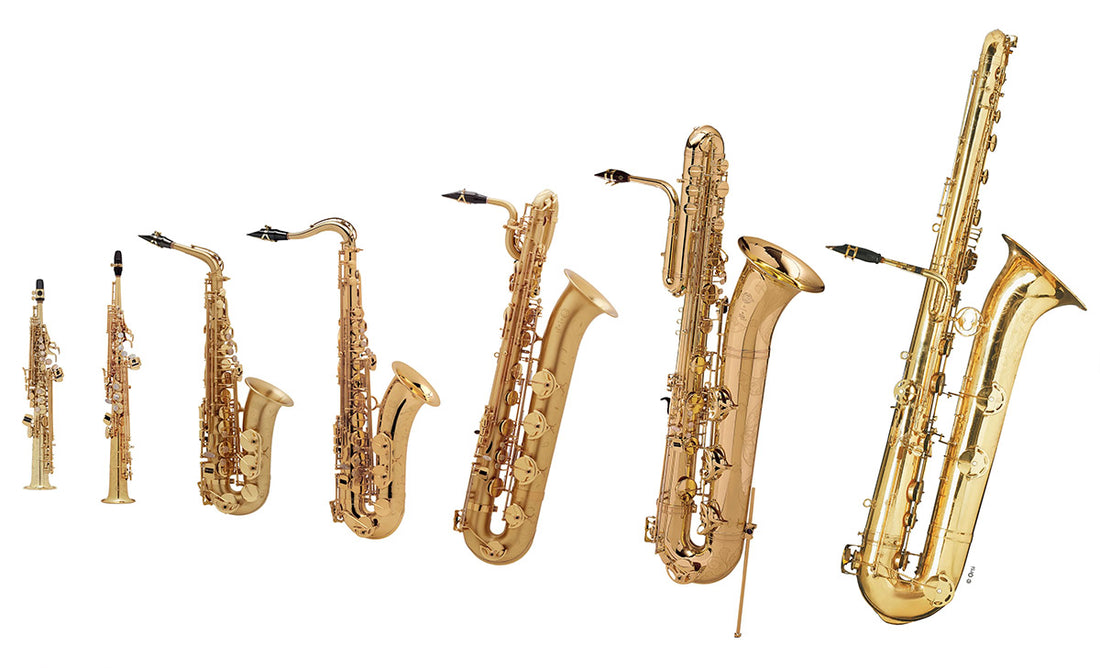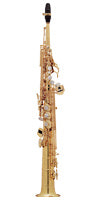The saxophone family

|
Right from the beginning, the alto and tenor saxophones have been the models most in demand amongst composers. Other members of the family, although less commonly used, have appeared progressively throughout the evolution of the classical repertoire. Today jazz, contemporary music and various other musical styles are in the process of reclaiming all the instruments of the saxophone family under their ever diversifying branches.
|
E♭ sopranino saxophone

Although little used today, the E-flat saxophone sopranino is increasingly in demand in jazz and contemporary music. It must be noted, however, that the accuracy and precision required to play this delicate instrument demands great dexterity. Nevertheless, it has found a home within various saxophones ensembles and concert bands.
B♭ soprano saxophone

Although curved sopranos also exist, the shape more commonly resembles the straight body of the clarinet. Its tone evokes that of the oboe, while its low register resembles the timbre of the English horn. In the saxophone quartet, it holds the role of first violin. Sydney Bechet introduced it into the United States upon his return from London in 1919. For the soprano in B♭, we can cite, among others, the concertante piece from Villa-Lobos, Fantasia. The version in C no longer exists.
E♭ alto saxophone

The most popular member of the saxophone family, it is on this instrument that many first discover the saxophone. Bizet immortalized it in his celebrated Arlésienne in which it was given the role of soloist. It has also been used by some influential composers from the beginning of the 20th century, notably Ravel in his orchestration of Moussorgsky’s Pictures at an Exhibition and Berg in his Concerto To the Memory of an Angel. Debussy later dedicated a Rhapsody to it and Glazounov his famous Concerto. Finally in jazz, Charlie Parker’s preference for this instrument conferred upon it its imprimatur. The alto saxophone in F (called mezzo soprano) is no longer manufactured.
B♭ tenor saxophone

It was largely through jazz that the true nature of the B-flat tenor saxophone has been revealed. In particular by Coleman Hawkins, a figure often present at the forefront of major musical innovation, and to whom the history of jazz owes much. Hawkins popularized this instrument through the interpretation of his celebrated Body and Soul in October 1939.
On the classical side, it can be found in Symphony No 4 from Vaughan Williams, and in Prokofiev’s Lieutenant Kije and Romeo and Juliet.
E♭ baritone saxophone

The deep and warm tone of the E-flat baritone saxophone provides a sound close to the cello and even to the human voice. But the baritone not only provides the bass voice of a quartet, it also constitutes the harmonic and rhythmic pulse of any group. Influential names in jazz like Gerry Mulligan and Pepper Adams have managed to successfully establish it as a soloist instrument.
B♭ bass saxophone

The size, weight and cost of the B-flat bass saxophone limit its presence within groups. It always provides an efficient basis in wind sections and various ensembles. Today, it is more and more integrated into jazz and attracts composers of contemporary and improvised music.
E♭ contrabass saxophone

The saxophone double bass in E♭ is very seldom used today. Despite its ability to give off impressively deep sounds, its repertoire is practically non-existent. Few examples are in circulation, its development having been rarely thoroughly studied.
Except for the double bass saxophone, which is rarely used, Henri SELMER Paris remains one of the only workshops in the world that retains the know-how to produce the entire family: sopranino, soprano, alto, tenor, baritone and bass.